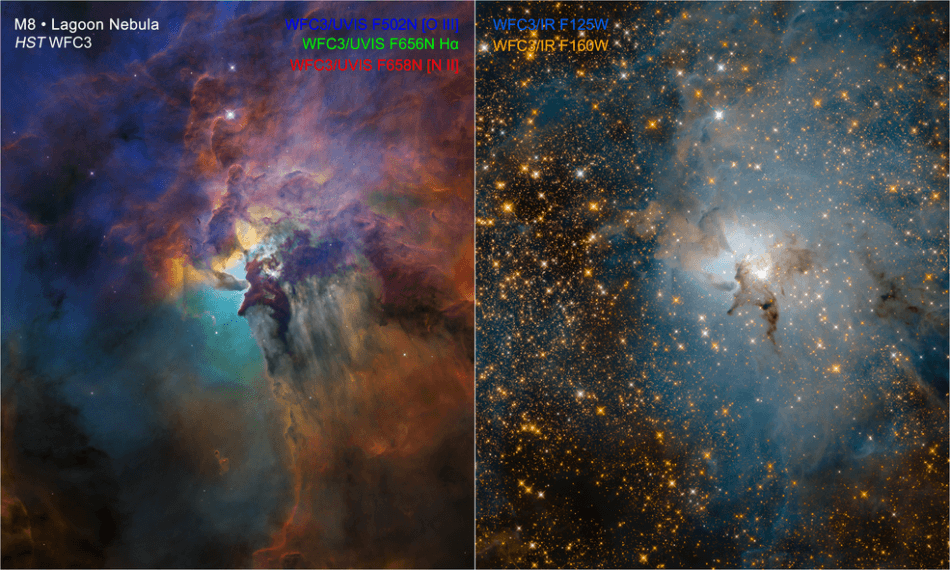Apr 23 2018
Two different views of the roiling heart of a massive stellar nursery, called the Lagoon Nebula, have been compared by the images captured by NASA’s Hubble Space Telescope. One of the images was taken in visible light and the other in infrared light. These images celebrate the 28th commemoration of Hubble Space Telescope in space.
 These NASA Hubble Space Telescope images compare two diverse views of the roiling heart of a vast stellar nursery, known as the Lagoon Nebula. The images, one taken in visible and the other in infrared light, celebrate Hubble’s 28th anniversary in space. (Image credit: NASA, ESA, and STScI)
These NASA Hubble Space Telescope images compare two diverse views of the roiling heart of a vast stellar nursery, known as the Lagoon Nebula. The images, one taken in visible and the other in infrared light, celebrate Hubble’s 28th anniversary in space. (Image credit: NASA, ESA, and STScI)
An illusionary landscape of mountains, cavities, and ridges of dust and gas can be seen in the colorful visible-light image. The gas-and-dust landscape has been formed by hurricane-like stellar winds and powerful ultraviolet radiation emitted by a monster young star. The star, named Herschel 36, is located at the center of the image and is nearly 200,000 times brighter than the Sun. This huge star has a temperature of 40,000 K and is 32 times more massive than the Sun. This star is even now highly active since it is young, just 1 million years old.
The powerful stellar winds, or streams of subatomic particles, and the scorching radiation are thrusting dust away in curtain-like sheets. Since the monster star has been emitting its natal cocoon of material, it is inhibiting the formation of other stars around it.
Yet, stars have been observed to have formed within dense clouds of dust and gas at the dark edges of this dynamic bubble-shaped ecosystem. Dense pieces of the cocoon resistant to erosion by the blistering ultraviolet light are represented by dark, elephant-like “trunks” of material and function as incubators for novice stars.
The star-filled image taken in near-infrared light by the Hubble Space Telescope exhibits a completely distinctive view of the Lagoon Nebula in contrast to its visible-light image. Infrared observations of the universe enable astronomers to pervade massive clouds of dust and gas to unearth hidden stars. Hubble’s observation provides a preview of the striking perspectives to be offered by NASA’s James Webb Space Telescope.
The most striking contrast between the visible and infrared images of this region captured by Hubble is the abundance of stars seen in the infrared image. Majority of these are highly distant, background stars positioned behind the nebula itself. Yet, some of these speckles of light are younger stars within the Lagoon Nebula. The Herschel 36 giant star located near the center of the image shines brighter than ever in the infrared image.
The thickest parts of the nebula are marked by dark smudges called Bok globules. Here, the still-forming stars and their planets are protected by dust. Although these dusty clumps cannot be penetrated by Hubble, they can be observed with the help of Webb.
Lagoon Nebula Zoom and Flythrough
This video zooms into the core of a rich star-birth region called the Lagoon Nebula, located in the constellation Sagittarius in the direction of our Milky Way galaxy’s central bulge. (Video credit: NASA, ESA, and G. Bacon, D. Player, J. DePasquale, F. Summers, and Z. Levay (STScI); Acknowledgement: Fujii, Digitized Sky Survey, ESO/VPHAS, and Crisp)